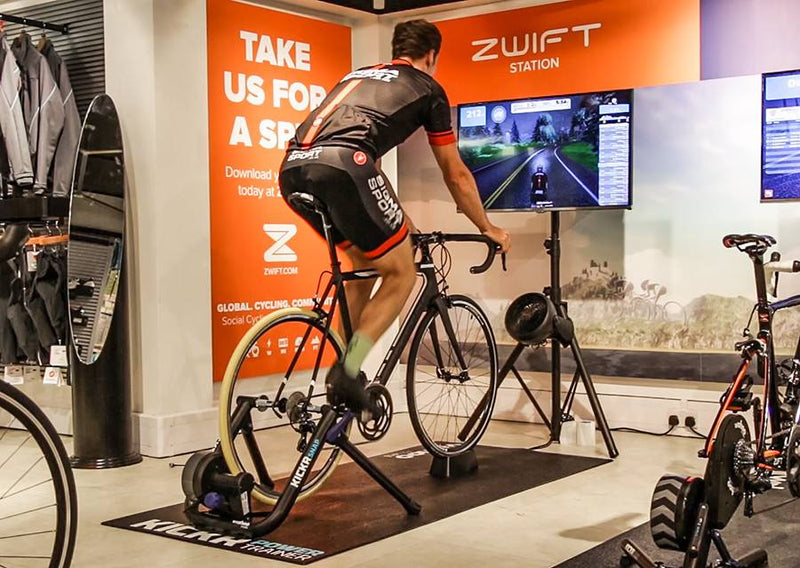If you’re around cyclists or triathletes for long enough, you’re likely to hear someone casually say, ‘so what’s your FTP’? While this may seem like a rather normal question in the triathlon community, training with power has become a popular training measure within the triathlon and cycling community over the past few years. Whether you’re a newbie or a seasoned vet, training with power can benefit you.
So what does it mean to Train with Power?
Training with power is a measure of your FTP and stands for functional threshold power. In the most simple form, it’s a way to measure your fitness. It measures the amount of watts (a unit of energy defined loosely as torque times cadence) that you could theoretically hold for an hour on the bike. Typically this is done by taking a percentage of a 20-minute max effort tests although you can find a wide variety of FTP testing options prescribed by different coaches.
Why train with power?
According to Kris Swarthout, USAT Level 2 Coach and owner of FinalK Sporting Services, any athlete who is serious about increasing their bike fitness should invest in a power meter. It will give you the most bang for your buck. ‘Training with a power meter is more than just trying to record monster watts on Strava, it’s about accurately creating, prescribing and execute workouts based on your real-time current fitness. A power meter can allow you to accurately execute the same workout whether you are on a trainer, on a mountain or on a trail. This is because watts are absolute, meaning a 200-watt effort is the same no matter where you do it.
So why should you invest in a device to train with power? Let’s take a look at some of our top reasons:
- You can scale your workouts to maximize your fitness gains. With power, each workout has very specific targets. Rather than putting in junk miles or wondering if you’re doing the workout correctly, you have a very measurable target with each workout.
- Measure improvement. The beauty of a power meter is it allows you to have an accurate measurement of your improvement on the bike. By having a specific and focused training block, you can see your FTP number improve over time. On the other hand, if you aren’t making gains on the bike, you have data to see where some of the problems may lie
- Learn to climb efficiently. One of the problems with climbing is people often burn out too quickly in the initial part of the climb. If you are able to measure your numbers on a power meter, you can learn to execute a climb in the most efficient way.
- Keeps you from overtraining. A big danger for the Type ‘A’ athlete is overtraining. When a workout doesn’t feel too hard, it seems like it wasn’t productive but most athletes actually spend too much time in the gray zone of training (too hard for their body to recover adequately for the next workout but not hard enough to be considered a high-intensity workout. A power meter gives you an accurate way to measure what zone you should be training in for that day. By the same token, if you tend to enjoy just going long and slow on your bike, a power meter will help you break through to that next level of challenge.
Power Meter Options
Powertap Pedals (single sided or Double Side)
Advantages - Quick installation, can easily be moved from bike to bike. Pedal based power is considered by many to be the ‘king of power’.
Disadvantage - Limited to the PowerTap cleats. Higher cost entry point.
Advantages - Pioneer readouts can offer you the most comprehensive data as well as offering a very budget friendly option to start that allows you to add on as you have the finances.
Disadvantages - One it’s on the bike, you cannot switch it or move it to another bike if you sell that bike.
Smart Trainers - although not technically power meters, smart trainers have built in systems to allow you to measure power. If you do most of your riding indoors and would rather make the investment in a high-quality trainer, a smart trainer may be your best option.
Wahoo Kickr - The Wahoo Kickr has become a favorite among triathletes with its built in power measurement, controlled resistance and open third party software options (easy to connect with Zwift, Trainerroad, Sufferfest, etc.)
Advantages - take off your wheel and everything is ready to go. You can train with power in the comfort of your own pain cave. No commute time or worries about safety on the roads.
Disadvantages - you aren’t able to take your power measurements outside but using a smart trainer can help you learn what the rate of perceived exertion should feel like when riding outdoors.
If you have more questions about products that will allow you to train with power or how to train with power, give us a call. We’re here to help you get the most out of your training and racing.


0 comments